Few things can turn a potentially great day into a bad one like a digestive problem. An imbalanced digestive system affects every aspect of life and in acute forms can be debilitating. Below I’m going to share with you some yoga postures that can facilitate and support good digestion. This sequence of postures can be completed in as little as fifteen minutes.
Digestive problems can ruin a good day, but yoga can help.
Don’t Forget Your Brain
But first, consider that the most important digestive organ is your mind. I know the brain is not technically part of the digestive system, but it, via the nervous system, controls the digestion process. The number one reason things go wrong with digestions is stress. Stress is connected to the autonomic nervous system. The autonomic nervous system controls everything in the body that’s automatic (or involuntary) such as digestion, heart rate, and respiration.
“[W]hen stress becomes chronic, as it is for so many of us today, it can be damaging to our digestive system.”
The stress response is embedded in the involuntary nervous system as a way to mobilize us for survival in a life-threatening situation. You may have heard this called the “fight or flight” response. It releases hormones in the body that gear it to fight or flee. To do this, it pulls blood flow away from the digestive and immune systems and sends it to the large muscle groups needed for mobilization. In small doses, this is a good thing. But when stress becomes chronic, as it is for so many of us today, it can be damaging to our digestive system.
So if I want you to take away one thing from this article it’s this: the best thing for digestion is less stress. Yes, even more important than what you eat or how much you exercise. This doesn’t mean you shouldn’t be mindful of what you eat and keep your body active. It means that even if you do these things, if you are in a chronic state of stress, you may still end up with digestive problems.
How Do I Reduce My Stress Levels?
The answer is so simple, so accessible, and so inexpensive you won’t believe it. It’s a drug you make and always have access to. It’s your breath. Less stress is as close as your next breath – literally.
“Abdominal breathing relaxes the digestive organs and stimulates peristalsis (wave-like motions in the body that contribute to digestion).”
Remember earlier I mentioned respiration is part of the involuntary nervous system? Well it’s also the one function of the involuntary nervous system that can be consciously controlled. Even if you’re not thinking about it, you are going to breathe. But you can also harness the power of your breath to affect the automatic functions of the body, such as digestion, in a positive way.
Sukhasana and Breathing
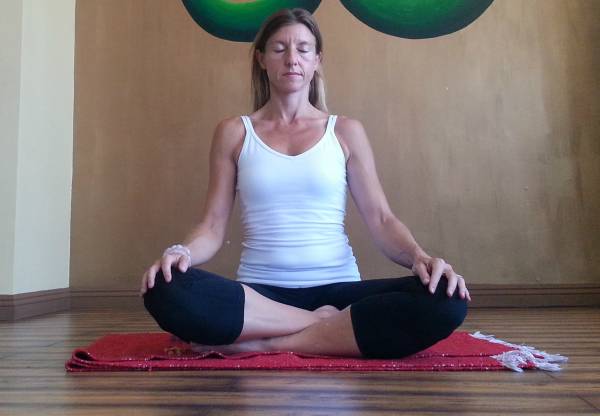
Let’s begin by cultivating our breath:
- Sit in easy pose (sukhasana). If your knees are higher than your hip points, then elevate your buttocks by sitting on a blanket or pillow.
- Close your eyes.
- Begin to feel your breath flowing in and out through the nostrils.
- Gradually slow your breath down to a three-count inhale and exhale. Breath in and out through the nose.
- When you inhale feel the belly expand. When you exhale feel the belly pull back toward the spine.
Sit and breathe in this way for two to ten minutes, depending on how much time you have for your practice. Abdominal breathing relaxes the digestive organs and stimulates peristalsis (wave-like motions in the body that contribute to digestion). Practice this type of breathing in all of the poses you’ll find below.
Apanasana
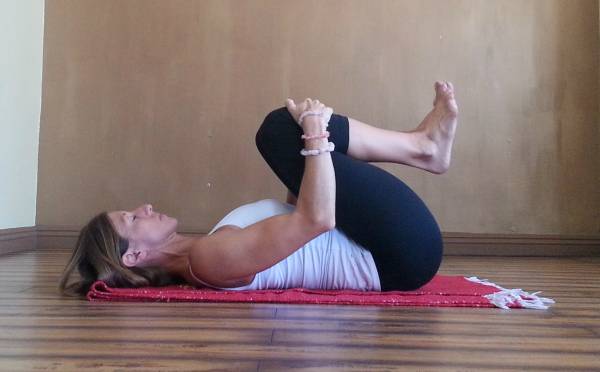
From a reclining position, bend the knees and draw them in toward the chest. You can place your hands on the shins or the backs of the thighs. Gently hug the knees in and focus on the abdominal breathing described earlier for thirty seconds to two minutes.
Cow Tilt, Cat Stretch

Come to all fours with wrists under shoulders and knees under hips. On an inhale, drop the belly down as the tailbone lifts up, creating a gentle arch in the lower back (keep abdominals slightly engaged to ensure you don’t overdo the arching in the lower back). The heart, throat, and gaze open upward, without over arching the back of the neck.
On exhale, round the back, drawing the tailbone under as the crown of the head releases toward the floor. You should feel the shoulder blades separate across the back. Press through the hands and the tops of the feet as you do this. Also make sure your inner feet and shins are parallel.
Repeat ten to twenty cycles on the breath.
Forward Fold and Half Forward Fold
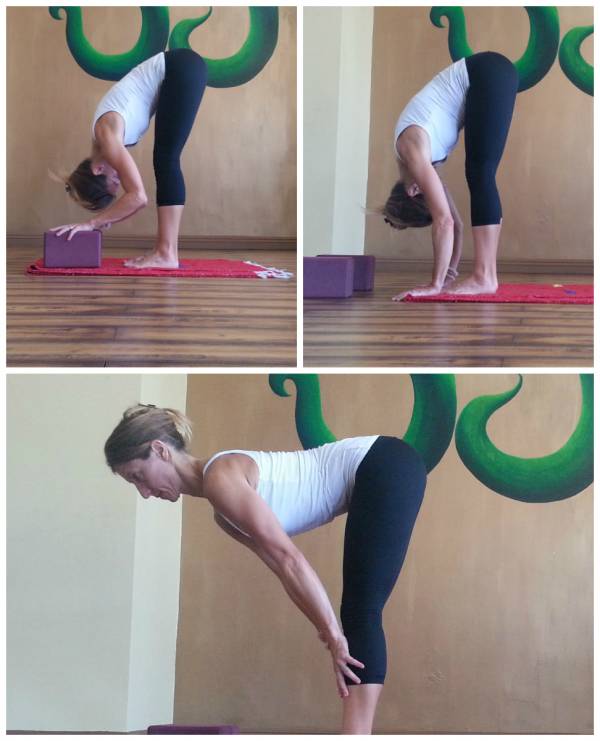
Bring yourself to a standing forward fold with your feet hip width apart. Be sure your knees are slightly bent. Place your hands on blocks or a footstool – anything to bring the floor closer to your hands depending on your flexibility.
On an inhale, place your hands on your shins and extend the front of your spine forward from the pubic bone to the throat. Be sure not to over arch the back of your neck. The gaze is forward but not too far up. Abdominals are slightly engaged. On an exhale, fold forward, softening the knees and the neck.
Repeat this combination three to five times, and then hold your forward fold for thirty seconds to a minute. Let your neck completely relax.
Squat Variations
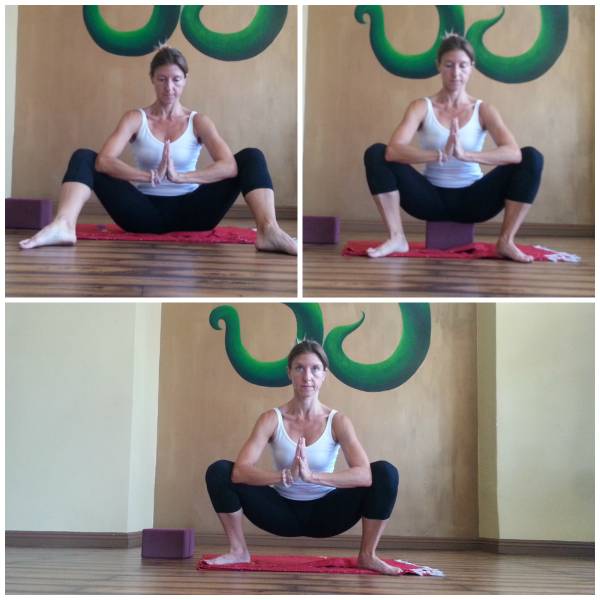
Next bring your feet wider than your hips. If you’re using a yoga mat, place your feet about as wide as the mat. The stance is different for everyone so experiment to find what works for you.
Squat down between the heels. As pictured above, you can use support underneath your buttocks or sit on the floor. If your heels don’t touch the floor, you can place a folded blanket or towel underneath them for support.
Bring your hands to your heart in a prayer position. Press the elbows into the inner thighs. Keep the feet active and draw the heels toward each other to create a lift. As you inhale, contract the anal sphincter muscles. As you exhale, release them. (If you don’t know what that is, then simply inhale and exhale the way you have been.)
Repeat your chosen variation for one to two minutes.
Seated Twist
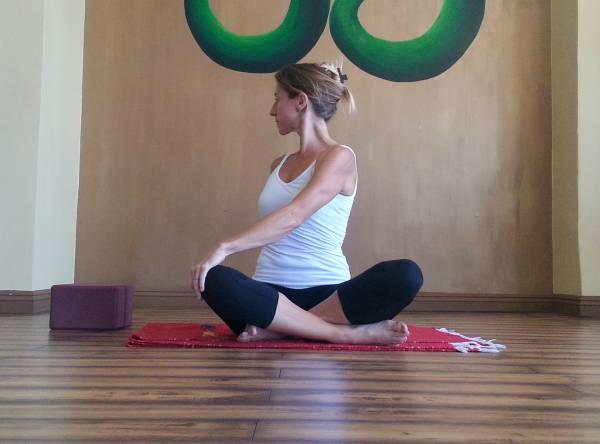
Sit in a cross-legged position, following the instructions from earlier. Inhale the arms above the head. Exhale to bring the right hand to the outer left thigh and the left hand to the floor behind your back. If the left hand doesn’t easily touch the floor, you can place a yoga block or anything that would double for that underneath your hand. As you inhale, lengthen the spine. As you exhale, twist from the lower, middle, and upper spine. Be sure to stay upright. Try to avoid leaning forward or back.
Do this for thirty seconds to one minute. Switch the crossing of your legs and do on the other side.
Seated Side Stretch
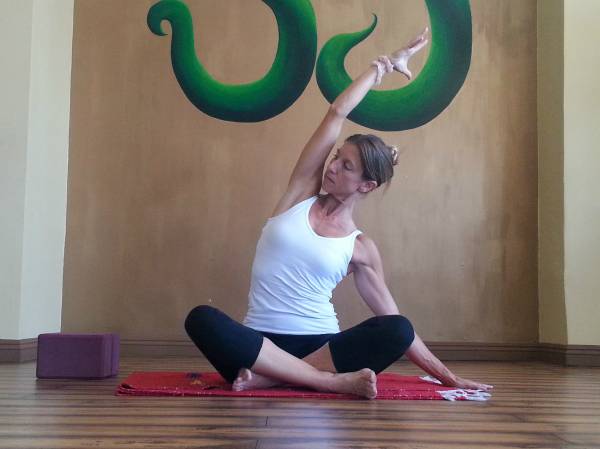
From the cross-legged position, place your right hand on the floor or on a yoga block. Inhale to lift the left arm up. Feel the stretch in the left side from the hip to the armpit. Inhale to lengthen the spine. Exhale to stretch to the right. The right elbow can bend to accommodate the stretch. Keep the shoulders relaxed and firmly ground both sitting bones.
Continue for thirty seconds to one minute. Switch the crossing of your legs and repeat on the other side.
Child’s Pose
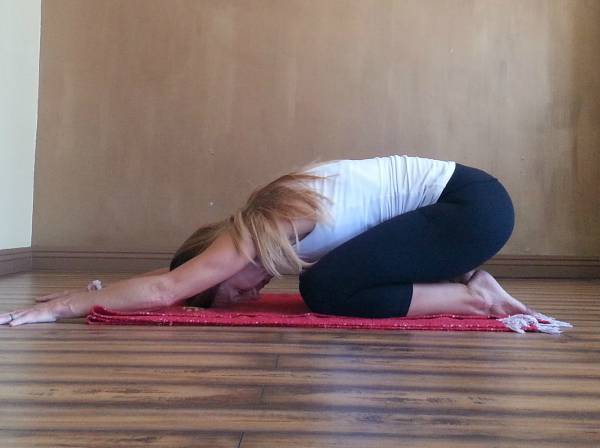
From a tabletop position, open your knees a little wider than your hips. Bring your big toes together and rest your buttocks back toward your heels. Keep your arms extended out in front and rest your forehead on the floor, a blanket, or a pillow.
Stay here for two to three minutes practicing the abdominal breathing described earlier.
Legs Up the Wall (Viparita Kirani)
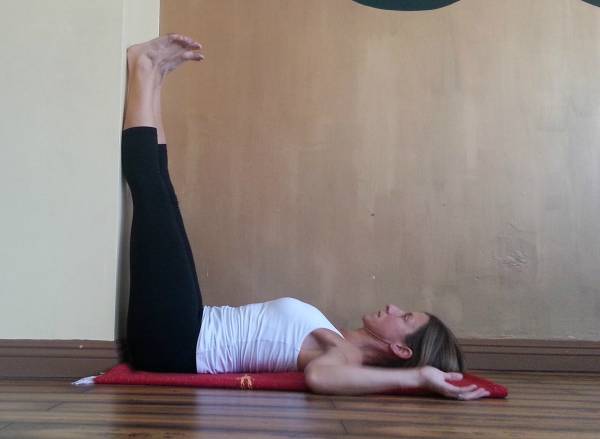
Finally, place a blanket next to the wall. Sit on the blanket with one hip against the wall and gently swing both legs up the wall. You may need to scoot yourself closer so your sitting bones are against the wall. Make sure your palms are facing up. Your arms can be straight or you can have your elbows bent in a cactus shape. Relax your feet.
Remain here for two to five minutes practicing the abdominal breathing described earlier.
Seek Balance
Though you can practice this entire sequence daily, it’s probably more realistic to commit to three times a week for a thirty-day period and then reassess. You can always pick one or two postures if you’re short on time. You’re intuition will guide as to what will bring the most balance to your system. The breath awareness suggested here is the most accessible and beneficial thing to incorporate into your daily life. If you do nothing but that, you will feel the results.
“[I]f I want you to take away one thing from this article it’s this: the best thing for digestion is less stress.”
Digestion consists of ingesting, digesting, assimilating, and eliminating. Beyond food, there are many other things we digest. We digest activity, information, education, and experiences. Often when one of those areas is out of balance it affects the physical digestive function. So always keep the big picture in mind. And remember that when you engage in practices of self-care such as these everything else in your life will be blessed because you show up a better person.
More Like This:
- Want to Improve Your Gym Performance? Start With Your Gut
- 5 Tips for Better Sleep and a Healthier Mind and Body
- 4 Questions Every Yoga Newbie Asks
- New on Pulse Beat Fit Today
Photo 1 courtesy of Shutterstock.






